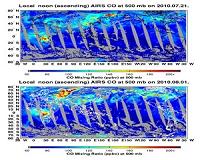 |
Paris, France (ESA) Aug 10, 2010 Envisat has been observing a rare event in the Arctic since early August - a giant iceberg breaking off the Petermann glacier in North-West Greenland. The Petermann glacier is one of the largest glaciers connecting the Greenland inland ice sheet with the Arctic Ocean. Upon reaching the sea, a number of these large outlet glaciers extend into the water with a floating 'ice tongue'. The ice tongue of the Petermann glacier was the largest in Greenland, with an extension of about 70 km until early August. This tide-water glacier regularly advances towards the ocean at about 1 km per year. During the previous months, satellite images revealed that several cracks had appeared on the glacier surface, suggesting to scientists that a break-up event was imminent. In the Envisat radar image taken on 3 August, the ice tongue was still intact but, on 4 August, a large part of the floating ice tongue was separated from the glacier, giving birth to what is currently the largest iceberg in the northern hemisphere. Such a process of detachment, called 'calving', occurs regularly on the Petermann glacier, with smaller calving events in summer 2008 and 2009. However large calving events are rare, with the last such significant event being documented in 1991 by ESA's ERS-1 satellite. The animation above was created by combining three Envisat Advanced Synthetic Aperture Radar (ASAR) acquisitions (31 July, 4 August and 7 August 2010) taken over the same area. The breaking of the glacier tongue and the movement of the iceberg can be clearly seen in this sequence. The detached iceberg is now about 30 km by 14 km in size with an area of about 245 sq km. It is floating away from Petermann glacier and will enter into the Nares Strait, which separates Greenland from the Ellesmere Island in Canada. The Nares Strait connects the Lincoln Sea and Arctic Ocean with the Baffin Bay. The strait is usually navigable by icebreakers during August/September, when sea ice extent is at its minimum after the summer melt period. Envisat ASAR images will be used in the coming days to monitor the movement of the giant iceberg in support of icebreaker navigation. The radar imaging system used by Envisat and other satellites is particularly suited to observe polar areas, as it can acquire images through cloud or fog, and night and day.
Share This Article With Planet Earth
Related Links Envisat Earth Observation News - Suppiliers, Technology and Application
 NASA Instrument Tracks Pollution From Russian Fires
NASA Instrument Tracks Pollution From Russian FiresPasadena CA (JPL) Aug 09, 2010 Drought and the worst heat wave Russia has seen in 130 years have sparked a devastating outbreak of wildfires across the nation this summer, primarily in the country's western and central regions. According to wire service reports and Russia's Emergency Situations Ministry, as of Aug. 6, 2010, some 558 fires were burning. The fires have killed at least 52 people, destroyed some 2,000 homes ... read more |
|
| The content herein, unless otherwise known to be public domain, are Copyright 1995-2010 - SpaceDaily. AFP and UPI Wire Stories are copyright Agence France-Presse and United Press International. ESA Portal Reports are copyright European Space Agency. All NASA sourced material is public domain. Additional copyrights may apply in whole or part to other bona fide parties. Advertising does not imply endorsement,agreement or approval of any opinions, statements or information provided by SpaceDaily on any Web page published or hosted by SpaceDaily. Privacy Statement |